Blue-throated Macaws: Repatriation and Reintroduction
Status:

Collaborators/Funders:
Paradise Park UK, African Lion Safari, Parrots Conservation Bolivia (CLB), Natural Encounters Conservation Fund (NECF), Servicio Nacional de Sanidad Agropecuaria e Inocuidad Alimentaria (SENASAG), Dirección General de Biodiversidad y Áreas Protegidas (DGBAP), the Gobierno Departamental del Beni, and Universidad Autónoma del Beni, José Ballivián.
The wild population of the Blue-throated Macaw (Ara glaucogularis) is currently in the low hundreds. Its survival hinges on successful breeding and the successful fledging of chicks into the adult population. Additionally, reintroduction efforts can help stabilise the population.
The World Parrot Trust (WPT) initiated its conservation work for the Blue-throated Macaw in 2002, collaborating with both local and international partners to study the species’ ecology and identify the key factors limiting the recovery of its wild population. Critical data revealed that the species’ small and fragmented population spans a large area, and would greatly benefit from active nest management and reintroduction efforts.
As a result of these findings, ex-situ breeding programs were launched with zoological partners including African Lion Safari in Canada, Paradise Park in the UK, and the Natural Encounters Conservation Fund in the US, all with the support of the Bolivian government. In all, over 30 Blue-throated Macaws from these institutions have been returned to Bolivia.
Status: IUCN Critically Endangered / CITES Appendix I
Population: 312-455 individuals, stable.
Threats: These macaws are at risk from predation, parasitism and disease of adults and chicks, and hunting for feathers and meat. There is a growing threat from Africanised bees. Trapping historically caused a near-extinction.
Range: Occurs only in Llanos de Mojos in NC Bolivia, concentrated east of the upper Río Mamoré, Beni. A smaller population exists in the Municipal Protected Area of the Great Tectonic Lakes of Exaltación.
Natural history: This macaw ranges in a small area in the Beni department in NC Bolivia in flooded areas such as savannas, palm groves and tropical forest in wet lowlands up to 300 m (984 ft). Its diet includes fruit pulp and liquids of Motacú Attalea and Acrocomia palms. It will roost with other parrots, such as Blue-and-yellow and Red-and-green Macaws. Breeding is August- December; nest is in a tree cavity.
